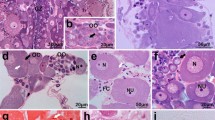Summary
Early development of Platynereis massiliensis was studied in serial sections of fixed embryos and in living or fixed embryos whose nuclei had been made visible with a fluorescent label. The unfertilized egg is an ellipsoid with three axes of differing length. The longest axis corresponds to the dorsoventral axis of the developing embryo. Egg volume is ten times that in the sibling species, P. dumerilii, mainly due to increased yolk content. The timing and spatial pattern of cleavage were observed from first cleavage to the 62-cell stage. Volumes of the blastomeres, their nuclei, their yolk-free cytoplasm and their yolk were determined from serial sections up to the 29-cell stage. In the P. massiliensis embryo, cell cycles are on average 3.7 times longer than in P. dumerilii; volume proportions among the blastomeres also differ and the macromeres containing the bulk of yolk are particularly large, but otherwise the cleavage patterns, differential segregation of yolk and yolk-free cytoplasm, and the histogenetic fates of the blastomeres are the same as in P. dumerilii. This equivalence of cell lineage and of cytoplasmic segregation mechanisms in both species, maintained in spite of the different appearance of the embryos, suggests functional importance of and selective constraint on these developmental features. The relatively accelerated divisions of the 2d cell line in P. massiliensis may be interpreted as the precocious development of cell lines which give rise to adult structures. Several structures, obviously functional in developing P. dumerilii, have lost their function in P. massiliensis: the egg contains few cortical granules, giving rise to only a moderate egg jelly layer in the zygote; prototroch cells develop cilia, but the heavy embryo is unable to swim; the larva develops three pairs of parapodia but, unlike the corresponding stage in P. dumerilii, is not capable of coordinate locomotion. This loss of motility is related to the brooding habit of the species developing inside the parental tube and is explained as the result of a switch from pelagic to benthic, protected reproduction in P. massiliensis.
Similar content being viewed by others
References
Conklin EG (1907) The embryology of Fulgur: A study of the influence of yolk on development. Proc Natl Acad Sci 64:320–359
Dorresteijn AWC (1990) Quantitative analysis of cellular differentiation during early embryogenesis of Platynereis dumerilii. Roux's Arch Dev Biol 199:14–30
Dorresteijn AWC, Eich P (1991) Experimental change of cytoplasmic composition can convert determination of blastomeres in Platynereis dumerilii (Annelida, Polychaeta). Roux's Arch Dev Biol 200:342–351
Dorresteijn AWC, Kluge B (1990) On the establishment of polarity in polychaete eggs. In: Marthy H-J (ed) Experimental embryology in aquatic plants and animals. Plenum Press, New York, pp 197–209
Dorresteijn AWC, Bornewasser H, Fischer A (1987) A correlative study of experimentally changed first cleavage and Janus development in the trunk of Platynereis dumerilii (Annelida, Polychaeta). Roux's Arch Dev Biol 196:51–58
Durchon M (1955) Sur le polymorphisme présenté par quelques Néréidiens (Annélides Polychètes) au moment de la reproduction. Bull Soc Hist Nat Aft Nord 46:180–194
Fioroni P (1971) Die Entwicklungstypen der Mollusken, eine vergleichend-embryologische Studie. Z Wiss Zool 182:263–394
Fischer A (1985) Reproduction and postembryonic development of the annelid, Platynereis dumerilii. Institute of the Scientific Film (IWF), Göttingen FRG (Film C 1577)
Freeman G (1982) What does the comparative study of development tell us about evolution? In: Bonner JT (ed) Evolution and development. (Dahlem Konferenzen) Springer, Berlin Heidelberg New York, pp 155–167
Gratzner HG (1982) Monoclonal antibody to 5-bromo- and 5-iododeoxyuridine: A new reagent for detection of DNA replication. Science 218:474–475
Hauenschild C (1951) Nachweis der sogenannten atoken Geschlechtsform des Polychaeten Platynereis dumerilii And. et M. Edw. als eigene Art auf Grund von Zuchtversuchen. Zool JahrbAbt Allg Zool Physiol Tiere 63:107–128
Hauenschild C, Fischer A (1969) Platynereis dumerilii. Mikroskopische Anatomie, Fortpflanzung, Entwicklung. (Großes Zoologisches Praktikum, Heft 10b). Gustav Fischer, Stuttgart, pp 1–55
Ivanova-Kazas OM (1981) Phylogenetic significance of spiral cleavage. Biologiya Morya 5:3–14
Lücht J (1987) Experimentelle und morphologische Untersuchungen zur Geschlechtsreifung und Fortpflanzung bei dem proterandrischen Polychaeten Platynereis massiliensis Moquin-Tandon (1869). Thesis, Free University of Berlin
Pfannenstiel H-D, Grünig C, Lücht J (1987) Gametogenesis and reproduction in nereidid sibling species (Platynereis dumerilii and P. massiliensis). Bull Biol Soc Wash 7:272–279
Plickert G, Kroiher M (1988) Proliferation kinetics and cell lineages can be studied in whole mounts and macerates by means of BrdU/anti-BrdU technique. Development 103:791–794
Raff RA (1987) Constraint, flexibility, and phylogenetic history in the evolution of direct development in sea urchins. Dev Biol 119:6–19
Rensch B (1959) Die phylogenetische Abwandlung der Ontogenese. In: Heberer G (ed) Die Evolution der Organismen. (2nd edition) Gustav Fischer, Stuttgart, pp 103–130
Richardson KC, Jarett L, Finke EH (1960) Embedding in epoxy resins for ultrathin sectioning in electron microscopy. Stain Technol 35:313–323
Romeis B (1989) Mikroskopische Technik. (17th edition) Urban and Schwarzenberg, München
Sato M, Tsuchiya M (1991) Two patterns of early development in nereidid polychaetes keying out to Neanthes japonica (Izuka). Ophelia [Suppl] 5:371–382
Schleip W (1929) Die Determination der Primitiventwicklung. Akad Verlagsgesellschaft mbH, Leipzig
Skiba F, Schierenberg E (1992) Cell lineages, developmental timing, and spatial pattern formation in embryos of free-living soil nematodes. Dev Biol (in press)
Weinberg JR, Starczak VR, Mueller C, Pesch GC, Lindsay SM (1990) Divergence between populations of a monogamous polychaete with male parental care: premating isolation and chromosome variation. Mar Biol 107:205–213
Wilson EB (1892) The cell-lineage of Nereis. A contribution to the cytogeny of the annelid body. J Morphol 6:361–480
Wistinghausen C von (1891) Untersuchungen über die Entwicklung von Nereis Dumerdii. Ein Beitrag zur Entwicklungsgeschichte der Polychaeten. Mitt Zool Stat Neapel 10:41–74
Author information
Authors and Affiliations
Additional information
Offprint requests to: A.W.C. Dorresteijn
Rights and permissions
About this article
Cite this article
Schneider, S., Fischer, A. & Dorresteijn, A.W. A morphometric comparison of dissimilar early development in sibling species of Platynereis (Annelida, Polychaeta). Roux's Arch Dev Biol 201, 243–256 (1992). https://doi.org/10.1007/BF00188755
Received:
Accepted:
Issue Date:
DOI: https://doi.org/10.1007/BF00188755




